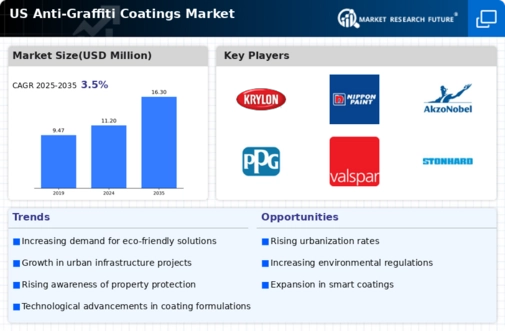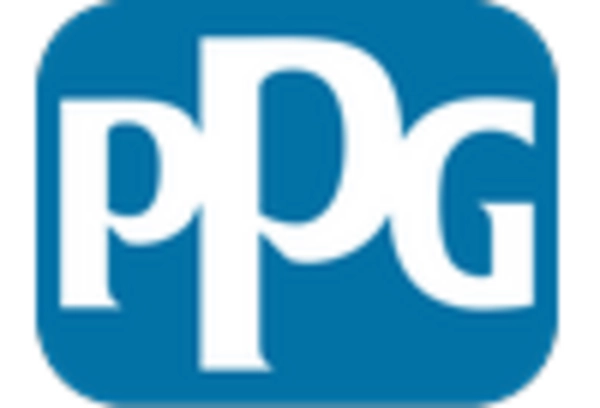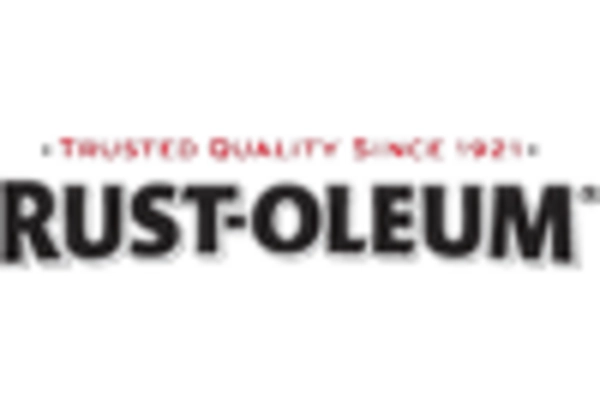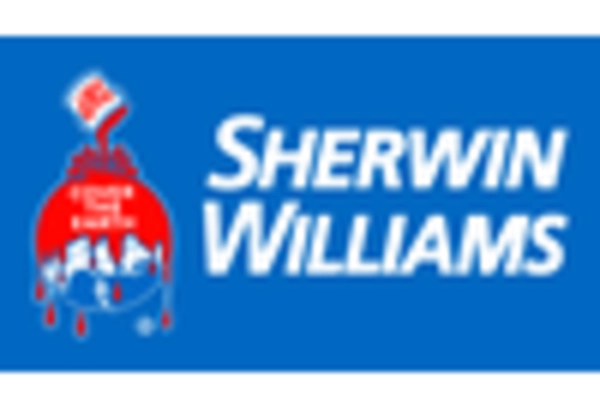Government Initiatives and Funding
Government initiatives aimed at urban beautification and crime reduction are significantly influencing the anti graffiti-coatings market. Various local and state governments in the US are allocating funds to combat graffiti vandalism, recognizing its impact on community aesthetics and safety. These initiatives often include grants and subsidies for property owners to apply anti graffiti coatings, thereby promoting the use of protective solutions. The anti graffiti-coatings market stands to benefit from these government programs, as they not only encourage the adoption of coatings but also raise awareness about the importance of maintaining public spaces. This support from governmental bodies is likely to enhance market growth, as more stakeholders engage in protective measures against graffiti.
Increased Vandalism and Crime Rates
The rise in vandalism and crime rates in various urban areas across the US has a direct impact on the anti graffiti-coatings market. As graffiti becomes more prevalent, property owners are compelled to seek effective solutions to mitigate damage. The anti graffiti-coatings market is witnessing a surge in demand for innovative products that offer long-lasting protection against graffiti. This trend is particularly pronounced in cities with higher crime rates, where the costs associated with graffiti removal can be exorbitant. Estimates suggest that the average cost to remove graffiti can range from $1,000 to $5,000 per incident, prompting property owners to invest in preventive coatings. This growing concern over vandalism is likely to sustain the market's expansion in the coming years.
Rising Awareness of Aesthetic Value
There is a growing recognition of the aesthetic value of buildings and public spaces in the US, which is driving demand for anti graffiti-coatings. Property owners, including businesses and municipalities, are increasingly aware that maintaining the visual appeal of their properties can enhance community pride and attract visitors. The anti graffiti-coatings market is responding to this trend by offering products that not only protect surfaces but also enhance their appearance. This dual functionality is appealing to a wide range of customers, from commercial property owners to local governments. As the market evolves, it is anticipated that the demand for coatings that combine aesthetic enhancement with protective qualities will continue to rise, potentially leading to a market growth rate of around 6% annually.
Urbanization and Infrastructure Development
The ongoing trend of urbanization in the US is a significant driver for the anti graffiti-coatings market. As cities expand and infrastructure projects increase, the need for protective coatings on public and private properties becomes more pronounced. Graffiti vandalism can lead to substantial repair costs, estimated at over $12 billion annually in the US. Consequently, municipalities and property owners are increasingly investing in anti graffiti-coatings to safeguard their investments. This trend is particularly evident in urban areas where public spaces, such as parks and transportation hubs, are frequent targets for graffiti. The anti graffiti-coatings market is likely to benefit from this urban growth, as more entities recognize the long-term cost savings associated with preventive measures against graffiti damage.
Technological Innovations in Coating Solutions
Technological advancements in coating solutions are playing a pivotal role in shaping the anti graffiti-coatings market. Innovations such as self-cleaning coatings and advanced polymer formulations are enhancing the effectiveness and durability of anti graffiti products. These developments not only improve the performance of coatings but also reduce maintenance costs for property owners. The anti graffiti-coatings market is experiencing a shift towards more sophisticated solutions that offer better resistance to various environmental factors. As these technologies become more accessible, it is expected that adoption rates will increase, further driving market growth. The potential for new applications and improved product performance suggests a promising future for the industry.

















Leave a Comment